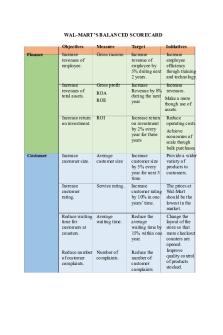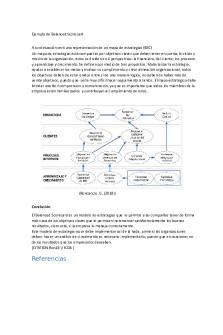Balanced Scorecard Test Bank 1 PDF

| Title | Balanced Scorecard Test Bank 1 |
|---|---|
| Author | John Vincent Dela Cruz |
| Course | Financial Markets |
| Institution | St. Mary's College |
| Pages | 6 |
| File Size | 66.8 KB |
| File Type | |
| Total Downloads | 59 |
| Total Views | 171 |
Summary
MCQ Test 1 on Balanced Scorecard and StrategicProfitability AnalysisMCQ In response to challenges arisen from competitors and new entrants, the strategies that must be considered by the company includes cost leadership demand inelasticity differentiated products both a and c DMCQ Considering two fis...
Description
MCQ Test 1 on Balanced Scorecard and Strategic Profitability Analysis MCQ In response to challenges arisen from competitors and new entrants, the strategies that must be considered by the company includes 1. 2. 3. 4.
cost leadership demand inelasticity differentiated products both a and c
D MCQ Considering two fiscal years 2013 and 2014, the actual units sold in 2013 and 2014 are 11000 and 12500 units respectively and selling price in year 2013 is $50 then revenue effect of growth is 1. 2. 3. 4.
$70,000 $75,000 $65,000 $73,000
B MCQ The balanced scorecard perspective which measures company's success in targeted segments of customers is classified as 1. 2. 3. 4.
internal business process perspective customer perspective learning perspective financial perspective
B MCQ The amount of capacity available other than capacity employed to meet the customer demand is classified as 1. 2. 3. 4. D
targeted capacity budgeted capacity recovery capacity unused capacity
MCQ In operating income strategic analysis, the strategic component which measures change in cost attributed to price of input in this year relative to price of input material in last year is classified as 1. 2. 3. 4.
internal process component growth component price recovery component productivity component
D MCQ The ability of organization to offer market offerings at lower prices in comparison of its competitors is classified as 1. 2. 3. 4.
inelastic demand product differentiation cost leadership elastic demand
C MCQ The balanced scorecard perspective which focuses on all the operations that leads to value creation process for customers is classified as 1. 2. 3. 4.
learning perspective financial perspective internal business process perspective customer perspective
C MCQ The quantity of output produced is divided by cost of all inputs used to calculate 1. 2. 3. 4.
engineered productivity targeted productivity partial productivity total factor productivity
D MCQ In operating income strategic analysis, the component which measures the change in operating income attributed to the change in output quantity is classified as 1. 2. 3. 4. B
internal process component growth component price recovery component productivity component
MCQ The example of financial perspective in balanced scorecard is 1. 2. 3. 4.
employee turnover rates operating capabilities and number of patents operating income and revenue growth customer satisfaction and market share
C MCQ The ability of organization to offer its services or products that must be perceived by customers as unique and superior in comparison of its competitors is called 1. 2. 3. 4.
inelastic demand product differentiation cost leadership elastic demand
B MCQ If the quantity of jackets manufactured is 2250000 units and the leather used to produce the output is 3500000 sq.m then direct materials partial productivity is 1. 2. 3. 4.
0.642 unit of jacket per sq.m of leather 0.342 unit of jacket per sq.m of leather 0.442 unit of jacket per sq.m of leather 0.542 unit of jacket per sq.m of leather
A MCQ Consider two years 2013 and 2014, the quantity of output produced in 2014 is divided by cost of input used in 2013 to produce output in 2014 to calculate 1. 2. 3. 4.
benchmark engineered productivity benchmark total factor productivity benchmark partial productivity benchmark total productivity
B MCQ The quantity of output produced is divided by quantity of used input to calculate 1. 2. 3. 4. C
targeted productivity total factor productivity partial productivity unused productivity
MCQ Considering the balanced scorecard, the perspective in which performance of organization includes 1. 2. 3. 4.
financial perspective learning and growth perspective customer perspective all of above
D MCQ In operating income strategic analysis, the strategic component which measures change in operating income attributed to change in price of outputs and inputs is classified as 1. 2. 3. 4.
internal process component growth component price recovery component productivity component
C MCQ In strategy formulation, the forces that must be focused for industry analysis includes 1. 2. 3. 4.
potential entrants in market customer's bargaining power supplier's bargaining power all of above
D MCQ The example of customer perspective in balanced scorecard is 1. 2. 3. 4.
employee turnover rates operating capabilities and number of patents operating income and revenue growth customer satisfaction and market share
D MCQ Considering two fiscal years 2013 and 2014, the selling price in 2013 and 2014 is $55 and $60 per unit respectively and actual units sold in 2013 are 25000 units then revenue effect of price recovery is 1. 2. 3. 4. C
$14,500 $135,000 $125,000 $12,500
MCQ The way an organization match its capabilities with available opportunities to accomplish its goals is classified as 1. 2. 3. 4.
elasticity incurrence off shoring strategy engineering
C MCQ The example of internal business perspective in balanced scorecard is 1. 2. 3. 4.
employee turnover rates operating capabilities and number of patents operating income and revenue growth customer satisfaction and market share
B MCQ The balanced scorecard perspective which measures strategy profitability and amount of operating income results from cost reduction is classified as 1. 2. 3. 4.
learning perspective financial perspective internal business process perspective customer perspective
B MCQ The approach used to manage unused capacity is 1. 2. 3. 4.
reengineering downsizing upgrading None of above
B MCQ The example of learning and growth perspective in balanced scorecard is 1. 2. 3. 4. A
employee turnover rates operating capabilities and number of patents operating income and revenue growth customer satisfaction and market share
MCQ The innovation process, operation process and post sales services are all sub processes of perspective called 1. 2. 3. 4.
internal business process perspective external business process perspective leadership perspective reengineering perspective
A MCQ The fundamental redesigning and rethinking of business processes to improve critical measures such as quality, speed, cost and customer satisfaction is classified as 1. 2. 3. 4.
reengineering differentiation bargaining targeting
A MCQ Considering two fiscal years 2013 and 2014, the input price in 2013 and 2014 are $9 and $11 per unit respectively and input units required in 2013 to produce output in 2014 are 30000 units then cost effect of price recovery is 1. 2. 3. 4.
$60,000 $6,000 $65,000 $6,500
A MCQ The translation of organization strategy and mission into performance measures to provide framework for strategy implementation is classified as 1. 2. 3. 4.
differentiation scorecard bargaining scorecard leadership scorecard balanced scorecard
D MCQ The example of direct engineered cost is 1. 2. 3. 4. B
indirect material cost direct material cost direct labor cost indirect labor cost...
Similar Free PDFs

Balanced Scorecard Test Bank 1
- 6 Pages

MAKALAH BALANCED SCORECARD
- 10 Pages

WAL-MART\'S Balanced Scorecard
- 2 Pages

Cumulative Balanced Scorecard 3
- 3 Pages

Ejemplo de Balanced Scorecard
- 2 Pages

Perspectives in Balanced Scorecard
- 11 Pages

Tugas BALANCED SCORECARD
- 13 Pages

Starbucks Balanced Scorecard
- 12 Pages

Balanced scorecard casos reales
- 122 Pages

Balanced Scorecard Kaplan e Norton
- 11 Pages
Popular Institutions
- Tinajero National High School - Annex
- Politeknik Caltex Riau
- Yokohama City University
- SGT University
- University of Al-Qadisiyah
- Divine Word College of Vigan
- Techniek College Rotterdam
- Universidade de Santiago
- Universiti Teknologi MARA Cawangan Johor Kampus Pasir Gudang
- Poltekkes Kemenkes Yogyakarta
- Baguio City National High School
- Colegio san marcos
- preparatoria uno
- Centro de Bachillerato Tecnológico Industrial y de Servicios No. 107
- Dalian Maritime University
- Quang Trung Secondary School
- Colegio Tecnológico en Informática
- Corporación Regional de Educación Superior
- Grupo CEDVA
- Dar Al Uloom University
- Centro de Estudios Preuniversitarios de la Universidad Nacional de Ingeniería
- 上智大学
- Aakash International School, Nuna Majara
- San Felipe Neri Catholic School
- Kang Chiao International School - New Taipei City
- Misamis Occidental National High School
- Institución Educativa Escuela Normal Juan Ladrilleros
- Kolehiyo ng Pantukan
- Batanes State College
- Instituto Continental
- Sekolah Menengah Kejuruan Kesehatan Kaltara (Tarakan)
- Colegio de La Inmaculada Concepcion - Cebu





